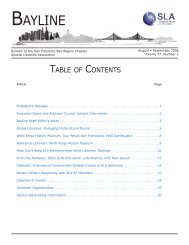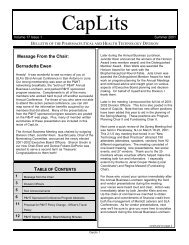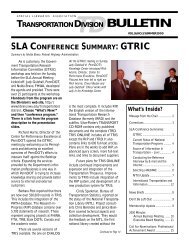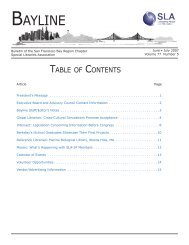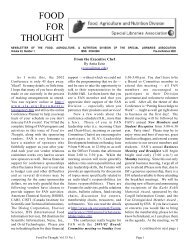Education Libraries - Special Libraries Association
Education Libraries - Special Libraries Association
Education Libraries - Special Libraries Association
You also want an ePaper? Increase the reach of your titles
YUMPU automatically turns print PDFs into web optimized ePapers that Google loves.
Photograph collections tend to be expansive, due<br />
in part to the fact that “photographs are prized in<br />
our culture because they are inexpensive, easy to<br />
acquire, and serve as accurate, detailed records of<br />
our environment and activities” (Schmidle, 1996).<br />
In fact, Ritzenthaler et al. [n.d.] argue that<br />
photojournalism has had “more influence on<br />
public thinking and opinion than any other today.”<br />
They continue to suggest that the function of<br />
photographs is to “provide evidence that<br />
something existed or that a particular event<br />
happened” (in Baxter, 2003). Baxter (2003) also<br />
points out the more interpersonal<br />
aspects of photography: “a<br />
photograph can provide a strong<br />
emotional reaction, it can capture a<br />
moment, it can convey a truth,<br />
maybe even ‘paint a thousand<br />
words’.” However, the context and<br />
purpose of a photograph does not<br />
often translate to individuals who<br />
were not present at the time of the<br />
event being captured. Thus,<br />
without an accurate record of the<br />
names, dates and events depicted, a<br />
photograph holds little historical<br />
value. “Stripped of its original<br />
context, an old photograph is<br />
reduced to mere curiosity”<br />
(Schmidle, 1996).<br />
Berinstein (1998) suggests libraries faced with<br />
organizing a photograph collection must start by<br />
first considering “the use to which your collection<br />
will be put.” Berinstein continues to state the use<br />
should “fit in with the mission of the organization”<br />
(1998). “Intelligent analysis” should be employed<br />
to ensure items are not incorporated into the<br />
collection simply because they exist, but rather<br />
because they add value to the collection (Baxter,<br />
2003). Schmidle (1996) acknowledges limited<br />
resources coupled with competing interests often<br />
create difficulty with assessing the value of any<br />
particular photograph. He states, “Librarians,<br />
archivists, and conservators must weigh economic,<br />
societal, cultural, and technological values to<br />
determine what is to be preserved, displayed or<br />
consigned to the depths of the vault” (1996).<br />
Components to Collection Management<br />
The Library of Congress states there are four basic<br />
components in the collection management of<br />
archive collections: inventory, appraisal,<br />
cataloging, and proper housing and storage (2002).<br />
Inventory and appraisal have been defined above<br />
as the determination of which objects are retained<br />
in the collection as evidenced by the institution’s<br />
mission. While there is no standardized approach<br />
to cataloging photographs, experts recommend<br />
providing the acquisition source, date (of<br />
acquisition and event depicted), subject and an<br />
accession number (Berinstein, 1998; Library of<br />
Congress, 2002). Baggett (2004)<br />
suggests the proper housing and<br />
storage of photographs involves<br />
storing “the files or envelopes<br />
vertically in an archival box or<br />
metal filing cabinet” as well as<br />
packing “the files or envelopes<br />
tightly so they are supported and<br />
stand upright.” Significant damage<br />
can be caused to photographs from<br />
improper handling. The Library of<br />
Congress states, “When handling<br />
photographs and negatives, be sure<br />
that hands are freshly washed, wear<br />
clean lint-free cotton gloves…and<br />
avoid touching the photograph<br />
surface” (2002).<br />
The technological revolution has<br />
also had many libraries scrambling to digitize their<br />
photographic collections. Schmidle (1996)<br />
recommends libraries adequately reflect on their<br />
motives for digitization. Digitizing photographs is<br />
beneficial in capturing an image before<br />
deterioration occurs. It also increases access to<br />
resources. However, “digitizing for preservation<br />
does not result automatically in increased access”<br />
(Schmidle, 1996). Digitization should only be<br />
considered when an institution is firmly<br />
committed to provide the resources (time,<br />
equipment and funding) required to maintain a<br />
digital collection.<br />
<strong>Education</strong> <strong>Libraries</strong>, Volume 31, No. 2, Winter 2008 32



